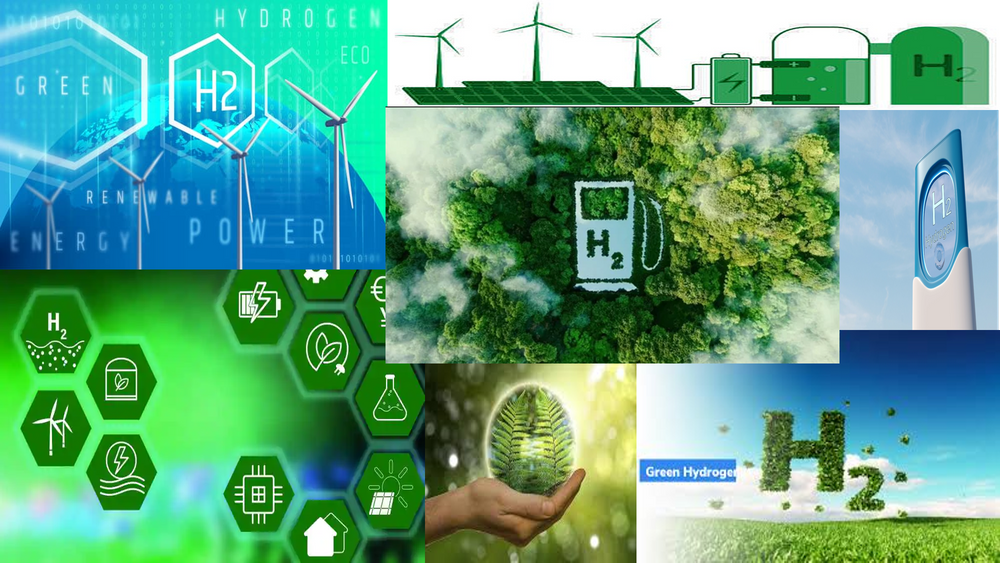India Towards Green Hydrogen Mission

By - Anurag Bajpai , Shikha Singh
Green hydrogen is attracting attention as a potential source of clean energy and is frequently envisaged as ‘the fuel of the future’ as it has the potential to displace fossil fuels in heavily polluting sectors that solar and wind cannot effectively target. But what is green hydrogen? What makes it ‘green’? And what are its uses and benefits? Here we explain this promising energy source, as well as its progress and prospects in South Asia.
Hydrogen gas can be used as a fuel in transportation, power generation and industrial activities. It does not release greenhouse gas emissions such as carbon dioxide when it is burned. Green hydrogen is the name given to hydrogen gas that has been produced using renewable energy, such as wind or solar power, which create no greenhouse gas emissions.
Hydrogen is the most abundant chemical element in the universe. Despite its abundance, hydrogen does not naturally exist as a gas in usable quantities, occurring almost entirely in compounds, such as water. Therefore, hydrogen must be produced using industrial methods. Most of these involve the reforming of natural gas – a fossil fuel.

Addressing the nation on the 75th Independence Day, Prime Minister Narendra Modi announced the National Hydrogen Mission with an aim of making India a hub for the production and export of green hydrogen. This is geared to make India energy independent before the country completes 100 years of its independence in 2047.

The union government plans to launch a comprehensive green hydrogen mission in two months to take forward the green hydrogen policy announced in February 2022. On January 4th2023 the Union Cabinet, chaired by the Hon’ble Prime Minister Shri Narendra Modi, has approved Green Hydrogen Mission. The initial outlay for the mission will be Rs. 19,744 Cr. The mission is also expected to list the sectors that will have to start using green hydrogen on a voluntary basis and a roadmap for sectors such as fertilizer and petrochemicals to use the green fuel mandatorily. The broad objective of the mission is to scale up Green Hydrogen production and utilisation and to align India’s efforts with global best practices in technology, policy and regulation.
The initial outlay also includes
- Rs.17,490 crore for the SIGHT programme,
- Rs.1,466 crore for pilot projects,
- Rs.400 crore for R&D, and
- Rs. 388 crores towards other Mission components.
The Mission will have wide ranging benefits- creation of export opportunities for Green Hydrogen and its derivatives; Decarbonization of industrial, mobility and energy sectors; reduction in dependence on imported fossil fuels and feedstock; development of indigenous manufacturing capabilities; creation of employment opportunities; and development of cutting-edge technologies.

This mission includes many sectors and is taking India towards the path of growth & development of Country. As announced by Hon’ble Prime Minister that before India’s 100th Independence Day by 2047 India will become energy independent, therefore this mission has some favorable outcomes by 2030.
- Development of green hydrogen production capacity of at least 5 MMT (Million Metric Tonne) per annum with an associated renewable energy capacity addition of about 125 GW in the country
- Over Rs. Eight lakh crore in total investments
- Creation of over Six lakh jobs
- Cumulative reduction in fossil fuel imports over Rs. One lakh crore
- Abatement of nearly 50 MMT of annual greenhouse gas emissions

Some Challenges of this Mission:
1. Extraction of Green Hydrogen- One of the biggest challenges faced by the industry for using hydrogen commercially is the economic sustainability of extracting green hydrogen.
2. Use of Technology- The technology used in production and use of hydrogen like Carbon Capture and Storage (CCS) and hydrogen fuel cell technology are at nascent stage and are expensive which in turn increases the cost of production of hydrogen.
3. Maintenance Cost- Maintenance costs for fuel cells post-completion of a plant can be costly.
4. Research & Development- The commercial usage of hydrogen as a fuel and in industries requires mammoth investment in R&D of such technology and infrastructure for production, storage, transportation and demand creation for hydrogen.

Although, there are certain challenges in the way of this mission but as it can be seen that budget is also allotted for different sector like (R&D, SIGHT Programme etc.) this will help to overcome these challenges and will lead this mission towards making clean fuel in the reach of common people of the country; which will reduce the dependency of fossil fuel & crude oil. This mission will encourage industries to use green hydrogen as a clean fuel, which improves the health of the environment & will help India to emerge as an export hub for Green Hydrogen.
All concerned Ministries, Departments, agencies and institutions of the Central and State Governments will undertake focused and coordinated steps to ensure successful achievement of the Mission objectives. Ministry of New & Renewable Energy will be responsible for overall coordination and implementation of the Mission.



